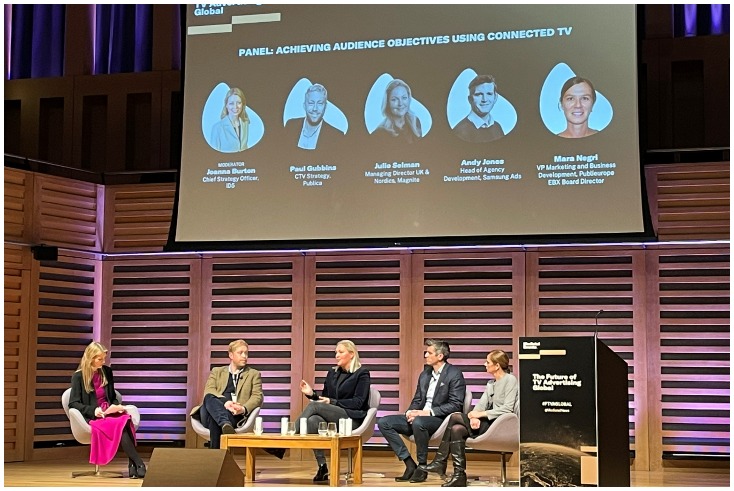FTVA Global: CTV is growing but technology needs to catch up

The future of Connected TV (CTV) advertising will be programmatic, automated and have seamless ad breaks, the Future of TV Advertising Global conference heard.
Between now and 2024, CTV and what is known as CTV is going to “double up” in the US, which means roughly $15bn will come in incrementally compared to what is being spent today, according to Thomas Bremond, general manager of International FreeWheel, a ComCast company.
More than half of this spend will come from walled gardens, which Bremond defined in the US as Roku, Hulu and YouTube, with the remainder coming from advertiser-funded video-on-demand, broadcasters and digital-first platforms.
Many panellists throughout the two-day conference made the point that the pandemic has accelerated the growth in popularity of CTV, with more people staying at home and signing up to streaming platforms. Meanwhile four in five (80%) of UK homes now own a TV that connects to the internet.
Another contributing factor was increasingly fragmenting audiences moving to new connected devices and a exponential growth in digital and video advertising investment and revenue.
‘Some CTV ad breaks pretty much suck’
However, publishers and marketers need the right tools to be able to use the full capabilities of connected TV in a privacy-first way, Bremond said.
He explained: “A lot of things I hear in market today is this opposing pressure between buyers and sellers – one side wants to accelerate the targeted aspects of unlocking linear and the other says yes we will get there but don’t force us because the tools that you are pushing me to use are not necessarily ready for me.”
This “push and pull” was also mentioned in another session by Paul Gubbins, vice-president of CTV strategy at Publica who said infrastructure for better CTV ad breaks needed to be put in place.
Gubbins said: “If you’re a linear TV advertiser for the last four years, you’ve had fantastic controls. In broadcast ad breaks, you can manage frequency, you can manage competitive separation, you can manage ad clash.
“Now they [linear advertisers] do not want to invest their money in the CTV ad breaks where their ads run back to back with a competitor’s, where somebody’s TV screen buffers, it loads, and then there’s a blank screen and then there’s 15 seconds for them, then the next ad plays and when the next ad does play – it’s the same as the one 15 seconds prior.
“I think the infrastructure needs to be in place that empowers streaming publishers to create seamless outbreaks so the content plays in a seamless way with the advertising.”
Gubbins mentioned that this is happening as more streaming publishers adopt a practice called server-side ad insertion (SSAI). Ad tech is going to be “instrumental” next year, he added, in creating those ad breaks and giving the publishers controls to give advertisers the levers that they need to invest more money into addressable CTV environments.
He concluded: “Without the seamless ad breaks, the ad dollars are not going to follow and, at the moment, I think we can all agree that some CTV ad breaks pretty much suck.”
Frequency capping is a big pain point for big brands and the main reason they are not investing more in addressable CTV ad breaks as they are unable to manage the basics of frequency, he added.
Julie Selman, now SVP head of EMEA at Magnite, predicted in the same panel: “In the next two years, I think programmatic and automation is going to be really key. Again, we need solve the tech for it but that’s going to be key.
“I don’t really like the distinctions for broadcast and FAST TV [free ad-supported streaming TV], the user they don’t see the difference. The user wants choice, they want good content, and they want seamless experiences so we need to be able to have the technology ready and I think in terms of automation, and just automating the seller and buyer interaction, that’s already there.
“In digital, that’s pretty much 99%. The I/O business doesn’t really exist there anymore, and it’s going in that direction so I think, from a tech perspective, that’s where we’re going and that’s where everyone needs to get on board.”
Future of CTV strategy is experimentation
Veriça Djurdjevic, chief revenue officer at Channel 4, told delegates the broadcaster was the first one to launch a data strategy but still has “lots more work to do”.
Certain digital elements of Channel 4’s strategy had been accelerated due to the pandemic, she said, commenting: “It’s about shifting how we think about ourselves in terms of pivoting to digital, to prioritise digital growth ahead of linear ratings.
Djurdjevic went on: “Given that we don’t have some of the constraints for some of the other broadcasters, particularly in Europe, in terms of shareholders, we have a little bit more space to to experiment and to try harder and other than these areas, and we’re taking full advantage of that.”
She added: “The future core strategy is absolutely dictating how we think about the world from measurement through to how we commission some content that we’re now producing, which platforms and devices were optimising that for and adopting and learning from some of the pure SVOD techniques as well.
“We’re also thinking about it from, from an advertising perspective, in terms of the products that we get and just thinking about integrating the platform experience and what that means to both viewers and advertisers.”
Pictured, above (L-R): Joanna Burton, chief strategy officer at ID5; Gubbins; Selman; Andy Jones, head of agency development at Samsung Ads; and Mara Negri, VP marketing and business development at Publieurope and EBX board director.




